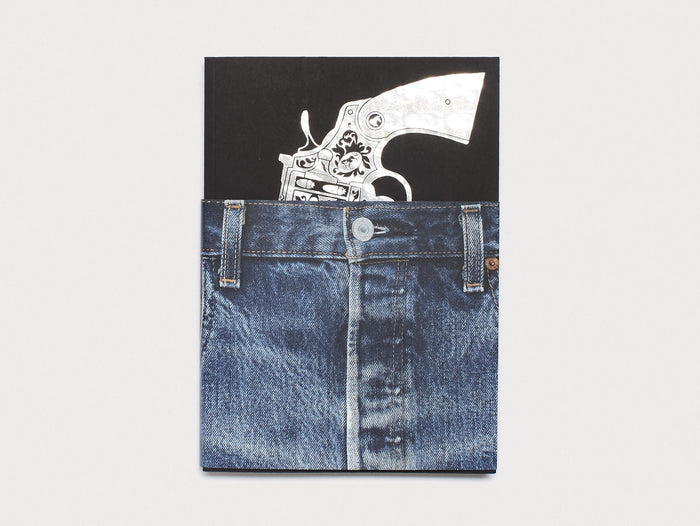
Martine Syms photographed by Tyler Adams
Author
Holly Connolly
Published
June 05, 2025
For Total, her first retrospective in France at Paris’ Lafayette Anticipations, the artist Martine Syms recreated elements of her L.A. studio in a concept store environment; her work displayed alongside retail stations selling T-shirts, notebooks and other merchandise. Cameras installed in the gallery made reference to surveillance culture, with the dual effect of turning the space into a film set, as well as a gallery and store. For the show, Syms also published Total, a book which traces her work since 2002, with essays from writers including Claudia Rankine and Hannah Black.
As an endeavour – gallery show that upends the idea of what a gallery show is, riff on the commodification and commercialisation of art, wide-ranging multimedia practice that spans video and printed matter – Total is also a kind of encapsulation of Syms herself, an artist whose frenetic, incredibly prolific output means she evades easy categorisation. She has described her editing process as one of “putting any two things next to each other and figuring out how they connect”; a phrase which could also go some way to describing her oeuvre.
Born in 1988, Syms grew up in L.A. and studied first at the School of the Art Institute of Chicago, before gaining an MFA at Bard College. Her work has spanned everything from video art, performance, running stores, a long-running NTS show, commercial fashion work, feature-length films (including 2022’s widely-lauded The African Desperate) and more besides. Equally, writing and publishing have always been a part of her practice. She spent her teens making zines and working at a bookstore, for a time ran the artist’s bookshop and project space Golden Age, and in 2011 founded Dominica Publishing, an imprint dedicated to exploring blackness in visual culture. Here she discusses making Total, the impulse to collect and making a book versus an exhibition.
I made my first artist book at the age of five
I read that as a teenager you made zines, in 2007 you opened Golden Age, an artist-run boutique and bookstore, and in 2011 you launched Dominica Publishing. Why do you think this relationship with different aspects of publishing has long been part of your practice and output?
I made my first artist book at the age of five. I put Vol. 1 on the front, which really got the attention of the adults. I had a zine called Anger Thermometer during my early teens. I worked at a bookstore — Ooga Booga — where I learned the history of artist publications because the job plugged me into a network of similar projects. I love reading and book culture. I found myself in this niche, and made myself cosy.

Martine Syms photographed by Tyler Adams.
Total is the monograph of my dreams
You have said before that time is your medium, the thing that you play with in your work. Total encompasses works as far back as 2002; how was it to go back over your oeuvre and reconsider older works?
Total is the monograph of my dreams. I was in very good hands: this was my third collaboration with the brilliant Claus Due. Antonine Scali Ringwald, Head of Publications at Lafayette Anticipations, is also a genius. We work well together and share a sensibility, so it was very easy. Once I finally got the book in my hands, I felt quite proud to see the body of work. I literally flipped through every single page, because Claus and I are both nerds and put so many things on the fold. It was all done perfectly by the monks.

Total by Martine Syms, published by Lafayette Anticipations
I'm more of a collector than an archivist
Relatedly, you have always worked a lot with archives, and with archival material. Do you feel you’ve been building your own archive in a way, through your artistic practice?
I'm more of a collector than an archivist. I actually purge frequently, and I don’t think it’s the artist’s responsibility to archive. I support others that do, but I don’t care. When I die, I'll let someone take care of that. I’m meticulous so they should be set with my original order. I collect a few different things: fake money, postcards, books, records. I have an encyclopedic mind for those things, like what year an album came out or whatever. I spent a lot of time at the library, at thrift stores, at flea markets. I still do.
This book is non-linear
How does ‘time’ figure when creating a book, which in some ways is quite a static object, and which you arguably have the least control over in terms of how your audience might interact with it?
This book is non-linear. You don’t need to read it front-to-back (and most people won’t) but it considers a few different scales and timelines: of my exhibition, of my artmaking, of my natal chart in Hannah [Black]’s essay. Then there’s the real-time experience of someone flipping through the monograph.

Total by Martine Syms, published by Lafayette Anticipations
Every exhibition only happens once
The book came out as part of your retrospective at Lafayette Anticipations, for which you created an immersive environment described both as a store and film set. How did the idea for the accompanying book come about? And did you want it to relate to the exhibition, or do you see it as a standalone thing?
Every exhibition only happens once. We can never do that again in that time or place. Books travel in a different way, and they can go places that my exhibitions can’t. That’s the beauty of the form.







